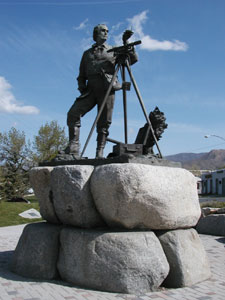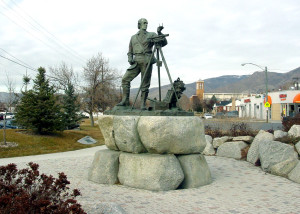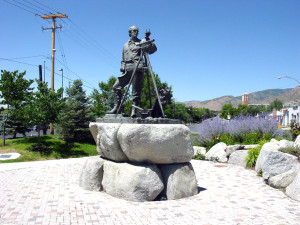Parley P. Pratt Monument, Salt Lake City

Photo by Alexander L. Baugh.
The Parley P. Pratt Park is located at 2100 South 2300 East near the mouth of Parley’s Canyon in Salt Lake City.
The park is a joint, two-year effort of the Big Kanyon Committee, and the Salt Lake City Parks and Recreation department. Contributions were made by individuals, families, and various organiations throughout the community.
Elder Pratt built a road from Parley’s Canyon into Salt Lake City. It was called “Big Kanyon.” The park commemorates the pioneer spirit.
Local artist, Ed Fraughton, created the monument and statue depicting Elder Pratt with an open toolbox and surveying instruments for building a road.
The Mormon Historic Sites Foundation assisted in the financial components of the project, assuring charitable contributions.
On November 16, 2020, a large truck that had lost its brakes plowed into the monument and knocked it to the ground.
Map and Directions
Address: 2100 South 2300 East, Salt Lake City, UT 84108.
Ownership Status
The monument to Parley P. Pratt is situated on public land. Anyone may view it seven days a week. There is no charge.
Photos


Articles & Resources
Park, statue memorialize early leader, Parley P. Pratt
Author(s): R. Scott Lloyd
Published in: LDS Church News
Publication Date: October 31, 1998
Parley P. Pratt, pathfinder, poet, valiant missionary of the gospel and apostle of Jesus Christ during the presidencies of Joseph Smith and Brigham Young, has been memorialized with a new sculpture and park in Salt Lake City.
Elder M. Russell Ballard of the Quorum of the Twelve dedicated the heroic-size bronze work and park Oct. 24 at the busy intersection of 2100 South and 2300 East.The location is near the mouth of Parley’s Canyon, today a major thoroughfare into the Salt Lake Valley. At the time Elder Pratt built a road through the canyon, it was called “Big Kanyon,” spelled with a K in deference to the phonetic alphabet that President Young attempted to establish among the LDS settlers.
Thus it was that the Big Kanyon Committee, a coalition of LDS and community interests, was organized within the last two years to develop the project.
It was initiated by the presidency of the Salt Lake Parleys Stake in response to a request from Church leaders that each stake consider a “Lasting Legacy Project” in connection with the Pioneer Sesquicentennial in 1997. With the intent of researching the neighborhood and preserving its history, the stake committee approached city officials in search of a location for a small marker or plaque. They were told that a perfect location would be a small city park under development at the intersection. Officials were searching for an art piece or focal point for the park.
“That meeting,” recalled committee chairman Michael Glauser at the dedication, “was the beginning of a marvelous marriage between our community and the city to create a ‘gateway’ into this neighborhood, which is one of the things that Mayor Deedee Corradini would like all of the neighborhoods to do before the Olympics [take place in Salt Lake City in 2002].”
The initial committee decided it needed more help. Four other stakes in the area were recruited to join the effort: Salt Lake Foothill, Salt Lake Monument Park, Salt Lake Monument Park North and Salt Lake Highland.
“From that point on, we received support from numerous individuals, families, city officials, businesses, schools and religious organizations,” Brother Glauser said.
The result was the statue, sculpted by Edward J. Fraughton, of Elder Pratt with surveying tools – a compass in his hand and a transit in front of him. Titled “Finding the Way,” the bronze work graces a tastefully landscaped plaza surrounded by boulders engraved with names of pioneers from all walks of life. The names were furnished by contributors to the project.
Among the significant contributors were members of the Jared and Charity Pratt Family Association, several hundred members of which attended the dedication as one of the activities of a family reunion held that day. Speaking to the audience, organization president Robert Grow said Jared and Charity – parents of Parley and his brother and fellow apostle Orson – probably have 50,000 or more descendants. Parley probably has about 30,000 descendants now, he added.
Elder Ballard, chairman of the Pioneer Sesquicentennial, spoke on behalf of the First Presidency in expressing appreciation to all who contributed to the park.
He said Elder Pratt “was a poet; he was a deeply inspired and religious man which is evidenced by the many hymns that we enjoy in our hymnbook that were authored by Parley P. Pratt.” Eight of those titles are in the current LDS hymnbook, including “The Morning Breaks,” “Come, O Thou King of Kings,” “As the Dew from Heaven Distilling,” and “Jesus, Once of Humble Birth.”
“One of the most important parts in the life of Parley P. Pratt, as far as I am concerned,” Elder Ballard said, “was his absolute obedience and willingness to do whatever the Prophet would ask him.”
To illustrate, he recounted a story from 1835 in which Elder Pratt was approached by Heber C. Kimball, who told him the Prophet Joseph wanted him to go to upper Canada on a mission. Elder Pratt replied that it would be very difficult just then because his wife was with child and was very ill, that he had no resources or money.
“Heber C. Kimball responded: ‘Parley, go. The Lord will bless you with a son, and his name shall be Parley. And you will have gold and silver enough for your means,’ ” Elder Ballard related.
With that, Brother Kimball left. Elder Pratt responded to the call, traveling on foot to Hamilton, Ontario, where he arrived weary, hungry and without resources. In a small park, he pleaded with the Lord to help him find the means to cross Lake Ontario by ferry to Toronto.
As Elder Pratt came out of the park, a stranger approached him and said, “I perceive you have need of some help; how can I help you?” Brother Pratt told the stranger of his needs, and the man gave him 10 Canadian dollars, telling him to look up a certain man in Toronto who would help him.
The man turned out to be John Taylor. Elder Pratt taught him the gospel and baptized him in Black Creek, which runs through the center of Toronto.
“On that same mission,” Elder Ballard said, “Parley P. Pratt met Joseph Fielding and his sisters, one of whom was Mary Fielding. They joined the Church. And so, on that mission, Parley P. Pratt was responsible for bringing into the Church the [future] third president of the Church, the mother of the sixth president of the Church, and the grandmother of the 10th president of the Church.”
Mary Fielding married Hyrum Smith; Elder Ballard is descended from them. Perhaps that is one reason he is such an admirer of Elder Pratt. In a conversation after the dedication proceedings, he said, “I could tell Parley P. Pratt stories all day!”
